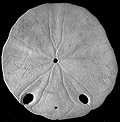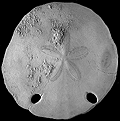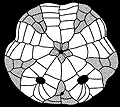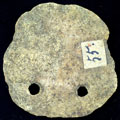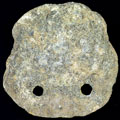The only other genus to have two posterior ambulacral lunules is Echinodiscus, and in that genus the lunules are narrow and slit-like, not ovate and its posterior petals are noticeably shorter than the anterior three petals. Kieria Mihaly, 1985, was established on the basis of three small and poorly preserved individuals (22 mm or less in length) showing posterior notches. In growth series of Amphiope the posterior lunules start as perradial notches and in the oldest species notches may continue throughout life. It is therefore likely that Mihaly`s material is simply juvenile Amphiope sp.
Stara & Borghi (2014) provide a detailed account of this genus and revise the Sardinian representatives. Stara & Sanciu (2014) discuss the broader differentiation of this genus from other members of the Astriclypeidae.
Agassiz, L. 1840. Catalogus systematicus Ectyporum Echinodermatum fossilium Musei Neocomiensis, secundum ordinem zoologicum dispositus; adjectis synonymis recentioribus, nec non stratis et locis in quibus reperiuntur. Sequuntur characteres diagnostici generum novorum vel minus cognitorum, 20 pp. Oliv. Petitpierre, Neuchâtel.
Mortensen, T. 1948. A Monograph of the Echinoidea IV.2 Clypeasteroida. C. A. Reitzel, Copenhagen.
Philippe, M. 1998. Les echinides miocenes du Bassin du Rhone: revision systematique. Nouvelles Archives du Museum d\'Histoire naturelle de Lyon, 36, 3-441, pls 1-26.
Stara, P. & Borghi, E. 2014. The echinoid genus Amphiope L. Agassiz, 1840 (Echinoidea, Astriclypeidae) in the Oligo-Miocene of Sardinia. Biodiversity Journal 5, 245-268.
Stara, P. & Sanciu, L. 2014. Analysis of some astriclypeids (Echinoidea Clypeasteroida). Biodiversity Journal 5, 291-358.
